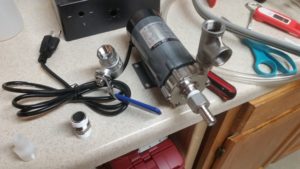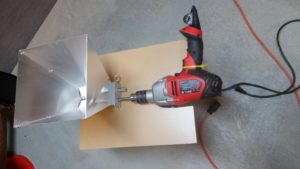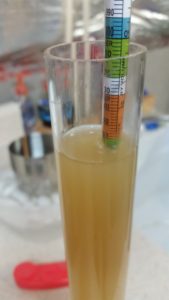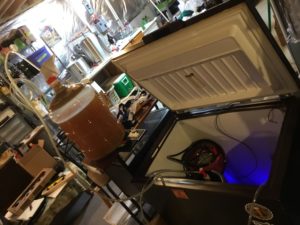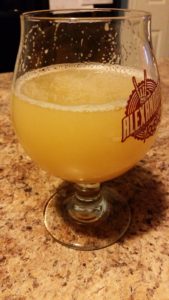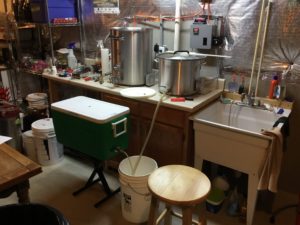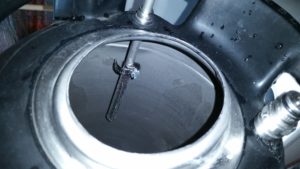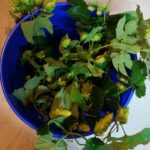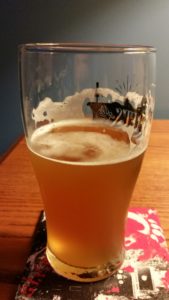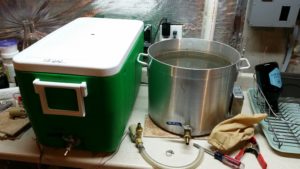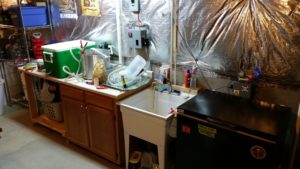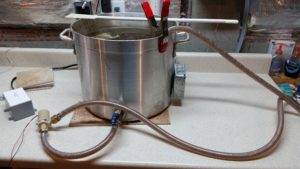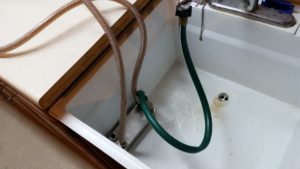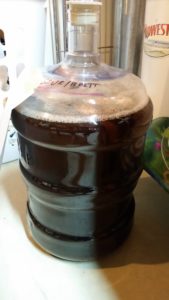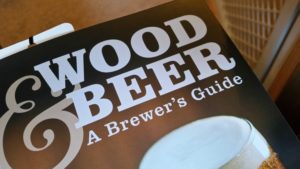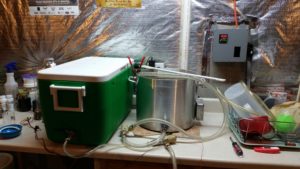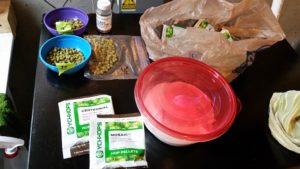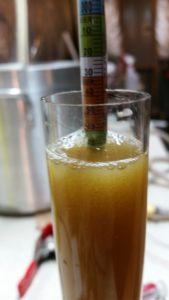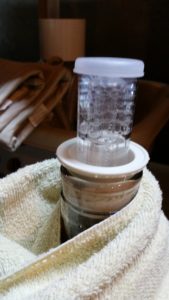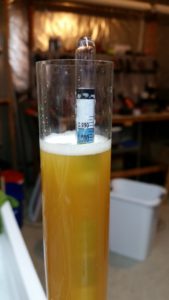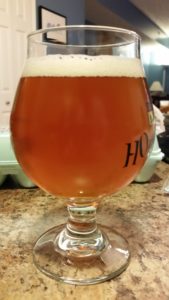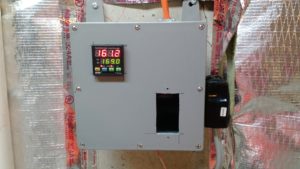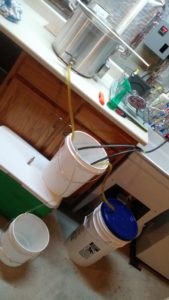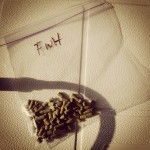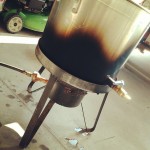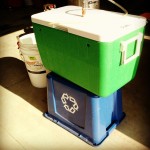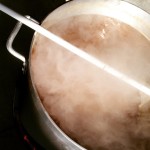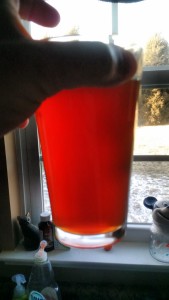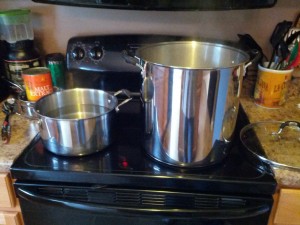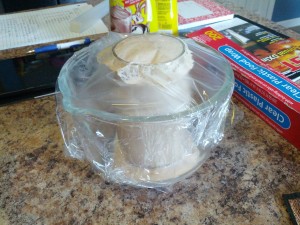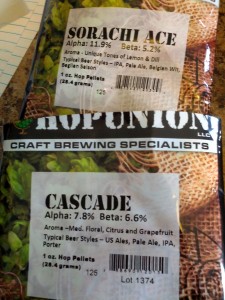Tag Archive: brewday
White IPA Brew Day
One of the beers that I’ve purchases as a 6-pack that didn’t stay in my fridge very long was MadTree’s Luna Lux (link includes recipe). For whatever reason, it became my go-to beer for all of six evenings, and that was after having (and thoroughly enjoying) a pint at a local pizza place.
So what does a homebrewer do when a place like MadTree gives you (and everyone!) the recipe? I think most homebrewers would spin it a little. Which I did…
Recipe Details
| Batch Size | Boil Time | IBU | SRM | Est. OG | Est. FG | ABV |
|---|---|---|---|---|---|---|
| 5.5 gal | 60 min | 70.6 IBUs | 6.3 SRM | 1.053 | 1.013 | 5.3 % |
| Actuals | 1.046 | 1.01 | 4.7 % | |||
Style Details
| Name | Cat. | OG Range | FG Range | IBU | SRM | Carb | ABV |
|---|---|---|---|---|---|---|---|
| white ipa | 21 B | 1.056 - 1.065 | 1.01 - 1.016 | 40 - 70 | 5 - 8 | 2.4 - 3 | 5.5 - 7 % |
Fermentables
| Name | Amount | % |
|---|---|---|
| White Wheat Malt | 1.5 lbs | 13.64 |
| Caramel Malt - 20L (Briess) | 8 oz | 4.55 |
| Pale Ale Malt 2-Row (Briess) | 9 lbs | 81.82 |
Hops
| Name | Amount | Time | Use | Form | Alpha % |
|---|---|---|---|---|---|
| Warrior | 0.12 oz | 60 min | Boil | Pellet | 15 |
| Jarrylo | 1 oz | 20 min | Boil | Pellet | 16 |
| Galaxy | 1 oz | 20 min | Aroma | Pellet | 14 |
| Citra | 1 oz | 20 min | Aroma | Pellet | 12 |
| Citra | 1 oz | 7 days | Dry Hop | Pellet | 12 |
| Galaxy | 1 oz | 7 days | Dry Hop | Pellet | 14 |
| Jarrylo | 1 oz | 7 days | Dry Hop | Pellet | 16 |
Miscs
| Name | Amount | Time | Use | Type |
|---|---|---|---|---|
| Lemon Peel | 1.20 oz | 0 min | Boil | Spice |
| Coriander Seed | 0.50 oz | 0 min | Boil | Spice |
Yeast
| Name | Lab | Attenuation | Temperature |
|---|---|---|---|
| Belgian Witbier (3944) | Wyeast Labs | 74% | 62°F - 75°F |
Mash
| Step | Temperature | Time |
|---|---|---|
| Mash In | 152°F | 60 min |
Download
| Download this recipe's BeerXML file |
Brew day was normal with only a few complaints of things I really need to fix – specifically I need to add releases that aren’t hose-barb connectors. And I still hate my plate chiller. This was the first brew day with my new pump, which worked splendidly, although there’s a few details I need to deal with (specifically, I need to have an outlet that I don’t block with kettles, I need to redo one of the fittings, and I need to mount this to a piece of wood or something as a base).
The grain milling needs some fixes, but they’re small. For starters, I need a thicker piece of wood to attach the drill to, and it needs to hold in place with the bucket. And I need to make sure the drill is spinning in the correct direction! Ultimately, I want to move milling outside because of the dust and the fact that I lost a few kernels to the floor.
This fermented for three weeks at 64F, which is the lowest end of the recommendations from Wyeast.
Packaging
I closed transfered from the fermenter to the keg.I’ve tried to do this once before, but this time worked better and with a few small modifications, this will work well.
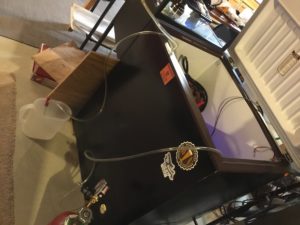
The destination keg is in the keezer, the line coming out and into the pitcher is from the gas in post on the keg.
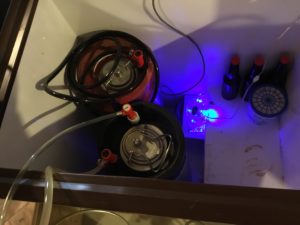
That’s what it looks like in the keezer… And yes, I have a lighted computer case fan circulating air in there.
Log
2018-02-25: Brewed
2018-03-04: 1.016 @ 67F
2018-03-07: 1.010 @ 67F
2018-03-13: 1.008 @ 67F
2018-03-16: 1.008 @ 67F
2018-03-18: Kegged
Tasting Notes
Appearance:hazy pale yellow with a thin lasting white head. Plenty of lacing on the glass.
Aroma: fruity hops with lemon undertone. No esters or phenols.
Flavor: light crackery malt with some orange and lemon flavor. Some spice in the background. Lasting light bitterness, but not overwhelming. No yeast character.
Mouthfeel: light-bodied. Dry and only slightly prickly from the carbonation.
Overall: I’m really enjoying this beer. The flavors really came together. I would have liked a lot more yeast character and a little more hop flavor and aroma, though. I think the next version may have a little bit more dry hopping and will be fermented warmer.
Awards: Won silver in the Hammerdown Brewcup 2018!
Cheers!
IPA Brew Day – Make IPA Great Again!
It was a dark and stormy brew day.
No, actually, it was cold and cloudy. I was inside though. I started the brew day at 7:30 AM by getting both kettles going with water – the BK had the mash tun heat up water and the HLT had my strike water (which I measured the prior night and filled the HLT to let the chlorine dissipate. I put a lid on the BK and then went upstairs to make breakfast for the family.
Backstory
I decided that since I now have two medals in styles that I like (but not love), I am going to try to medal in styles that I love – which basically means IPA. Maybe APA. Probably also British Bitter. Possibly dunkelweisen too (we’ll see). This is the first of that – I want to make an IPA that hits all the marks in the right spot. While I have been really enjoying some NEIPAs (specifically those from Listermann Brewing), this one will be clear, bitter, and aromatic. I want only some malt sweetness, and I definitely want it to take a backseat to the hops.
Brew Day
Upon returning to the basement brewery, I pulled the lid giving myself a nice steam burn on my left arm. I realized the element was at the max despite being set to ‘5’. I think the SSR is melted. I pulled the plug on the BK and drained the water into the mash tun to preheat while I added 5 ml of acid to the HLT for the mash water. Once the mash tun was mostly empty, I dumped the rest and dumped the grain into it. I shut the element off on the HLT and doughed in, hitting a mash temp of 154ºF, which only dropped to 152ºF over the hour rest. Mash pH was good, at about 5.3. After the hour, I recirculated and lautered for more sweet wort than I’ve ever received for first runnings – it was around 3.1 gallons, I was shooting for 3.5 gallons. Looks like the union I installed into the mash tun helped! I began the batch sparge and 10 minute rest and then dumped the first runnings into the BK. After the rest, I recirculated and lautered for just under 3.5 gallons for the second runnings and added the second runnings to the first in the boil kettle. I stirred and pulled a sample and then began boil.
And what a boil it was. Since the SSR was melted, it’s like using a propane burner on max. I started with around 6.5 gallons, and my final volume was around 5 before chilling caused me to lose some more (maybe 0.5 gallons, I ended up with 4.5 in the fermenter). When adding my 15 minute hop addition, I rigged the plate chiller and started recirculating boiling wort through it without running anything in the cold side. 15 minutes later, I shut off the element and turned on the cold water to begin chilling. At some point my pump failed, as it wasn’t pumping anything. My response to this was to use gravity to chill to my bottling bucket, and then drain the bottling bucket through the plate chiller and into the fermenter. This worked (I got down to 72ºF or so), but it was a pain and subjected the wort to some oxygen when it is most vulnerable to oxidization.
I pitched the yeast, I decided to use Denny’s Favorite, which appears to be from North Coast Brewing (the people that make Old Rasputin). The Fermentation temperature reached 75ºF around 24 hours post-pitch, and around 40 hours post-pitch was down to 70-72ºF.
Recipe
.
[beerxml recipe=”http://www.runningonbeer.net/wordpress/wp-content/uploads/2017/11/MakeIpaGreatAgain.xml” metric=false mhop=false misc=true]
Serving
After conversing with some fellow homebrewers on Reddit, I decided to give this a week to 10 days in the fermenter, crash it, rack it to a keg with an added hop sock of the dry hops and slow carbonate it over a week or so.
Notes
2017-11-11: Brewed
2017-11-19: Kegged
https://twitter.com/HamBrew807/status/933109708378034177
Cheers!
Fresh Hop Brew Day
With the new boil kettle and controller ready and wet tested, it was time to brew. What better time than when I have fresh Chinook hops coming off the vine!
I didn’t get enough from my two bines, so I had two packs of pellets to supplement the fresh hops.
I doughed in and hit my temp of 154, but too much acid adjustments caused it to fall. I should have let it go, as Brulosophy has shown that pH may not be as important as I think it is.
I ran into a few problems with yeast. I had an old Northwest Ale yeast that I harvested from an old batch and kept in my keezer, but it didn’t do anything in a starter. So I found a London Ale smack pack kept in the same keezer that was six months old. It didn’t inflate nor did it react in a starter. So I dropped by the LHBS and found a pack of Denny’s Favorite that appeared pre-smacked (although I thought I felt the pack in it). I gave it a day to inflate while I left the wort in my keezer to chill from the high-80s to hopefully below 70. No inflation. I pitched both it and some S-04, and of the pack that I thought I felt – it was in it, intact. Fermentation was quick but hot – the sticker on the side showed 79 at one point!
I’m calling this a British “Ordinary Bitter”.
Finished Beer
Appearance: copper colored, light carbonation with a thin white head. Good lacing.
Aroma: Earthy and bready
Flavor: bready, some orange (potentially marmalade), some earthiness or pine, but it is not promintent. Slight bitterness. Not strong at all.
Mouthfeel: smooth, medium dry finish with lasting but light citrus bitterness.
Ch-ch-ch-changes
I need to buy a pump. The ability to whirlpool while watching the temperature of the wort drop is worth every penny. Right now, I have one shot to send wort through my plate chiller and it doesn’t get it chilled enough.
I need to make progress on the fermentation chamber #2. I have a peltier element and several fans that can make this happen, all I need is some foam insulation and plywood (for structure) and some time to work on it.
Brew Log
2017-09-02: brewed on a rainy day
2017-09-05: fermentation appears finished
2017-09-13: moved to keezer for cold crashing
2017-09-15: kegged, pressurized to 30 PSI to carbonate
2017-09-16: removed gas line, took taste pour, left on normal carb (11 PSI)
Flanders Red Brew Day
The Recipe
The recipe is fairly simple, I’ve posted it before but I’ve made a few changes.
Recipe Details
| Batch Size | Boil Time | IBU | SRM | Est. OG | Est. FG | ABV |
|---|---|---|---|---|---|---|
| 5.5 gal | 60 min | 12.7 IBUs | 13.5 SRM | 1.053 | 1.012 | 5.4 % |
Style Details
| Name | Cat. | OG Range | FG Range | IBU | SRM | Carb | ABV |
|---|---|---|---|---|---|---|---|
| Flanders Red Ale | 23 B | 1.048 - 1.057 | 1.002 - 1.012 | 10 - 25 | 10 - 16 | 2 - 2.7 | 4.6 - 6.5 % |
Fermentables
| Name | Amount | % |
|---|---|---|
| Pilsner (2 Row) Bel | 8 lbs | 71.11 |
| Wheat - Red Malt (Briess) | 1.5 lbs | 13.33 |
| Caramel/Crystal Malt - 60L | 8 oz | 4.44 |
| Oats, Flaked | 8 oz | 4.44 |
| Vienna Malt (Briess) | 8 oz | 4.44 |
| Carafa II | 4 oz | 2.22 |
Hops
| Name | Amount | Time | Use | Form | Alpha % |
|---|---|---|---|---|---|
| Tettnang, U.S. | 1 oz | 60 min | Boil | Leaf | 4.5 |
Miscs
| Name | Amount | Time | Use | Type |
|---|---|---|---|---|
| Lactic Acid | 1.00 ml | 60 min | Mash | Water Agent |
| Irish Moss | 1.00 tsp | 15 min | Boil | Fining |
Yeast
| Name | Lab | Attenuation | Temperature |
|---|---|---|---|
| Roselare Belgian Blend (3763) | Wyeast Labs | 80% | 55°F - 80°F |
Mash
| Step | Temperature | Time |
|---|---|---|
| Mash In | 156°F | 90 min |
Fermentation
| Step | Time | Temperature |
|---|---|---|
| Primary | 4 days | 67°F |
| Secondary | 10 days | 67°F |
| Aging | 30 days | 65°F |
Download
| Download this recipe's BeerXML file |
Note: in the above, ignore the aging part, this is going to take a while… Also, my hops may not be very strong. I’m using year+ old homegrown hops, and in the past I think their strength has been low.
Brew Day
Brew day went generally without a hitch.
I mashed in with 3.5 gal of water at 174F, which settled to 156F. I let it rest, stirring occasionally, for 80 minutes when I added about a gallon of water at 190F. After 10 minutes, I vorlaufed and collected 3.5 (ish) gallons of wort, and batch sparged with around 3.25 gallons of water at 190F, which rested at 165F (about 5F below the target 170F). After all that, the pre-boil gravity was 1.057.
Boil was the standard one hour boil. 15 minutes prior to the end of the boil, I started the pump through the plate chiller, discarding the first little bit that pushed through and then recirculating through the boil kettle, creating a whirlpool. At the end of the hour, I set the PID to a low temperature (50-ish F) and turned the cold water on to the plate chiller. Chilling to about 70F took under 15 minutes.
It’s fermenting away now…
Oak Aging
Somehow, I’m going to get some oak in this. I don’t know how I’m going to do it, so maybe this will help…
Log
12/28/2016: Brewed, SG 1.051. Forgot to get pH reading.
1/5/2017: 1.008, pH 4.15. No acidity. Very bready.
1/14/2017: 1.008, pH 4.23. Light acidity. Still bready, but acid beginning to counter malt sweetness.
1/29/2017: 1.008, pH 4.34. More acid. pH meter is clearly fucked. It needs more time, but bready-ness is generally gone.
2/26/17: pH = 4.26. Oakey.
3/12/17: pH = 4.12. Oakey still.
5/1/17: pH = 4.15. Still a little oakey, but better. Starting to become pleasing.
6/10/17: pH = 4.08. Pronounced oakiness, but a slightly fruity aroma and flavor.
(this will be updated as things change)
8/24/17: pH = 3.78. Oak & stone fruit aroma, more sour. Lots of oak retronasally.
10/8/17: pH = 3.49. Malt aroma, sour cherry-ish finish and aftertaste.
12/23/17: Malt aroma, dark fruit flavor. Ready to bottle.
12/26/17: Bottled 4.5 gal with 3.5 oz corn sugar. Rehydrated some 71B-1122 wine yeast and added to bottling bucket. Yield 42 bottles.
Imperial Hoptrooper Brew Day and Tasting Notes
On November 20, I brewed my biggest (and most successful in terms of numbers) beer – a double IPA. Recipe inspiration came from MadTree’s High series, which is a series of IIPAs that are quite popular and very well rated (note: there are three “highs” that I know of, the Galaxy and Citra, which are linked in the text, and Azacca which is not… but it’s also f**king tasty! There may have also been a Mosaic High).
The recipes are similar. I did a fair bit of ‘back of the napkin’ analysis on the two beers, looking at the percentages of grain, the AAU at each addition, etc. I ended up with the recipe below.
Recipe Details
| Batch Size | Boil Time | IBU | SRM | Est. OG | Est. FG | ABV |
|---|---|---|---|---|---|---|
| 5.5 gal | 60 min | 123.7 IBUs | 5.9 SRM | 1.074 | 1.014 | 7.8 % |
Style Details
| Name | Cat. | OG Range | FG Range | IBU | SRM | Carb | ABV |
|---|---|---|---|---|---|---|---|
| Double IPA | 22 A | 1.065 - 1.085 | 1.008 - 1.018 | 60 - 120 | 6 - 14 | 2.4 - 2.9 | 7.5 - 10 % |
Fermentables
| Name | Amount | % |
|---|---|---|
| Pilsner (Hoepfner) | 10.5 lbs | 72.41 |
| Vienna Malt (Briess) | 2.25 lbs | 15.52 |
| Caramel/Crystal Malt - 40L | 8 oz | 3.45 |
| Carapils (Briess) | 4 oz | 1.72 |
| Corn Sugar (Dextrose) | 1 lbs | 6.9 |
Hops
| Name | Amount | Time | Use | Form | Alpha % |
|---|---|---|---|---|---|
| El Dorado | 1 oz | 60 min | Boil | Pellet | 15 |
| Galena | 1 oz | 60 min | Boil | Pellet | 12.5 |
| Centennial | 0.5 oz | 30 min | Boil | Pellet | 10 |
| Mosaic (HBC 369) | 0.5 oz | 30 min | Boil | Pellet | 12.3 |
| Centennial | 0.5 oz | 15 min | Boil | Pellet | 10 |
| Mosaic (HBC 369) | 0.5 oz | 15 min | Boil | Pellet | 12.3 |
| Centennial | 1 oz | 15 min | Aroma | Pellet | 10 |
| Mosaic (HBC 369) | 1 oz | 15 min | Aroma | Pellet | 12.3 |
| Centennial | 2 oz | 0 min | Dry Hop | Pellet | 10 |
| Mosaic (HBC 369) | 2 oz | 0 min | Dry Hop | Pellet | 12.3 |
| Chinook | 1.5 oz | 0 min | Dry Hop | Pellet | 13 |
| Citra | 1 oz | 0 min | Dry Hop | Pellet | 12 |
Mash
| Step | Temperature | Time |
|---|---|---|
| Mash In | 152°F | 60 min |
Download
| Download this recipe's BeerXML file |
I kept closer to the size of the Citra High recipe, mostly because I am still working through efficiency issues (it’s getting better, though). I still didn’t get MadTree’s efficiency, but to be fair, I’m targeting 75%, not 82%!
Brew Day
I’m happy to say that the only issues during brew day was how long it took and higher than expected grain absorption. I started later in the day (around 2:30 PM) and it didn’t end until maybe 6:30PM. There were no stuck sparges, clogged lines or chillers, boil boiled. I ended up with about 4.5 gallons into the fermenter, which is less than the 5.5 gallons I was targeting. However, the lower volume works better with my 7.5 – 8 gallon kettle.
Throughout fermentation, the temperature (as measured on the side of the fermenter) stayed at 68, which is a nice perfect temperature.
Tasting Notes
Aroma: Grapefruit mostly
Appearance: Copper, opaque. White head that starts thick and persists as a thin head.
Taste: Tongue lashing bitterness with citrus tones. Some alcohol flavor.
Mouthfeel: Moderately carbonated, slight citrusy tartness lingers past the dry finish.
Overall Impression: I’m biased, but I love this beer. I’ve been drinking the heck out of this!
OG: 1.071
SG: 1.005
ABV: 8.7%
IBU: 124
SRM: 6
What’s Next With This Recipe?
I want to try two things – one is maybe a little less bitterness. The other is honey instead of sugar. I’m wondering if some Orange Blossom honey would work well with the citrus based hops.
Cheers!
Another IPA Brew Day
So I decided later than usual on a Saturday to brew. This is a brew that I wanted to do the prior weekend, but my home AC was on the fritz and adding a bunch of humidity to it would not have been a very smart move.
This was an interesting brew day for two reasons. A large portion of the brew day was spent thinking that I would be preparing to brew the following day. I built an electric panel to fix the dangerous setup I had previously.
The thing is, I didn’t have the plug on the cord from the boiler ready. Once I did that, I added water and started things up. Then I went to work on preparing the mash tun. In my last post, I had the stuck sparge from Hell. I did NOT want that happening again. I added some plumbing solder in some strategic places and scrubbed down the copper. At that point (and after messing up and fixing solder joints twice, and since leaks don’t really matter here the mess ups were pretty important to fix), I decided to go ‘all in’ and start mashing.
I love problems that fix themselves!
This brew day had one minor mess up – for my IPA, I have hops at first wort (in the kettle), 15, 5, knockout, and dry. I did first wort, 15, 10, and knockout. Oops. It also had one issue that I thought would be a huge problem – my sparge water kept heating even after the PID said things were off. I didn’t notice until the water hit 205º F, and the heat was still on despite the output light on the PID controller not being on. So I unplugged the boiler to keep the water from boiling and let it cool. Later, when it was time to heat the water back up to sparge temperatures, I plugged the boiler back in and let it heat back up. And it worked correctly. And it worked correctly through the entire boil, too. I love problems that fix themselves!
They leak
Chilling had been an issue in the past, and I still reign supreme at having the most fucked up chilling schemes. This one isn’t much different. I bought a plate chiller on Amazon a few weeks ago. The water inlets and outlets were standard hose fittings. My house is six years old, and the cheap washing machine lines were something that was on the list of things to replace. I decided to purchase new stainless steel lines for the washing machine and use the old lines for the plate chiller.
They leak. Somehow in the process of unhooking them from the back of the washing machine and the wall and putting them on the plate chiller, they decided to leak. And these weren’t leaks that could be fixed by torquing down the connectors or using pipe tape (which is unnecessary on these connectors). And I made sure the O-rings were in the hose connectors.
So I did what any sane person would do. Since I didn’t have enough hose to set the plate chiller in the sink (that would have been optimal), I put the chiller in a bucket. Which started to fill. So to avoid flooding part of my basement, I used a small hose to siphon the leaking water out of the main bucket into another so I could dump water without moving the plate chiller around.
So on the shopping list is two new hoses. Because had I had not-leaking hoses, the plate chiller would have worked very well. And even allowing a lot of the trub go through was okay (I use pellet hops). I’m not sure what temperature I got things down to. Put the ale pail into the fermentation chamber and set it to chill at about 6:30. I ended up pitching the yeast at midnight or so.
The Recipe
The recipe has changed a little. I wanted it a little less malty and a little more crisp.
Recipe Details
| Batch Size | Boil Time | IBU | SRM | Est. OG | Est. FG | ABV |
|---|---|---|---|---|---|---|
| 5 gal | 60 min | 71.4 IBUs | 5.4 SRM | 1.070 | 1.013 | 7.6 % |
| Actuals | 1.051 | 1.01 | 5.4 % | |||
Style Details
| Name | Cat. | OG Range | FG Range | IBU | SRM | Carb | ABV |
|---|---|---|---|---|---|---|---|
| American IPA | 14 B | 1.056 - 1.075 | 1.01 - 1.018 | 40 - 70 | 6 - 15 | 2.2 - 2.7 | 5.5 - 7.5 % |
Fermentables
| Name | Amount | % |
|---|---|---|
| Pale Malt (2 Row) US | 7 lbs | 50 |
| Vienna Malt | 6 lbs | 42.86 |
| Cara-Pils/Dextrine | 1 lbs | 7.14 |
Hops
| Name | Amount | Time | Use | Form | Alpha % |
|---|---|---|---|---|---|
| Cascade | 2 oz | 15 min | First Wort | Pellet | 6.6 |
| Cascade | 0.5 oz | 15 min | Boil | Pellet | 6.6 |
| Citra | 0.5 oz | 15 min | Boil | Pellet | 12 |
| Galaxy | 0.5 oz | 15 min | Boil | Pellet | 11 |
| Cascade | 0.5 oz | 5 min | Boil | Pellet | 6.6 |
| Citra | 0.5 oz | 5 min | Boil | Pellet | 12 |
| Galaxy | 0.5 oz | 5 min | Boil | Pellet | 11 |
| Cascade | 1 oz | 15 min | Aroma | Pellet | 6.6 |
| Citra | 1 oz | 15 min | Aroma | Pellet | 12 |
| Galaxy | 1 oz | 15 min | Aroma | Pellet | 11 |
| Cascade | 1 oz | 7 days | Dry Hop | Pellet | 6.6 |
| Citra | 1 oz | 7 days | Dry Hop | Pellet | 11 |
| Galaxy | 1 oz | 7 days | Dry Hop | Pellet | 11 |
Miscs
| Name | Amount | Time | Use | Type |
|---|---|---|---|---|
| Irish Moss | 0.25 tsp | 15 min | Boil | Fining |
Yeast
| Name | Lab | Attenuation | Temperature |
|---|---|---|---|
| American Ale (1056) | Wyeast Labs | 75% | 60°F - 72°F |
Mash
| Step | Temperature | Time |
|---|---|---|
| Mash In | 148°F | 60 min |
Now the wait. One week (as of time of writing) to add dry hops, and one week to absorb. Then bottling and another week to two weeks to wait. I WISH IT WAS DONE ALREADY.
Cheers!
Friend of Hades IPA Recipe
So I’m starting to experiment with different malts. I started looking into various SMaSH recipes and started seeing people use different base malts. So I decided to base this one on Vienna malt instead of the normal 2-row malt. I also added some carared for color, some carapils for head retention, and crystal 40 for a touch of sweetness and color. I also kicked up the hops quite a bit since my last (extract+partial mash) IPA. The last (also first) IPA I brewed had 7oz of hops (3 oz of Cascade, 2 oz of Citra and Galaxy). This time, I added an extra 3 oz of hops. I also experimented with first wort hopping and steeping (the closest I can get to hopstanding right now).
Here is the recipe.
Recipe Details
| Batch Size | Boil Time | IBU | SRM | Est. OG | Est. FG | ABV |
|---|---|---|---|---|---|---|
| 5 gal | 60 min | 67.7 IBUs | 11.5 SRM | 1.066 | 1.015 | 6.7 % |
| Actuals | 1.051 | 1.01 | 5.4 % | |||
Style Details
| Name | Cat. | OG Range | FG Range | IBU | SRM | Carb | ABV |
|---|---|---|---|---|---|---|---|
| American IPA | 14 B | 1.056 - 1.075 | 1.01 - 1.018 | 40 - 70 | 6 - 15 | 2.2 - 2.7 | 5.5 - 7.5 % |
Fermentables
| Name | Amount | % |
|---|---|---|
| Vienna Malt | 9 lbs | 69.23 |
| Carared | 2 lbs | 15.38 |
| Cara-Pils/Dextrine | 1 lbs | 7.69 |
| Caramel/Crystal Malt - 40L | 1 lbs | 7.69 |
Hops
| Name | Amount | Time | Use | Form | Alpha % |
|---|---|---|---|---|---|
| Cascade | 0.5 oz | 15 min | First Wort | Pellet | 6.6 |
| Cascade | 0.5 oz | 60 min | Boil | Pellet | 6.6 |
| Cascade | 0.5 oz | 15 min | Boil | Pellet | 6.6 |
| Citra | 0.5 oz | 15 min | Boil | Pellet | 12 |
| Galaxy | 0.5 oz | 15 min | Boil | Pellet | 11 |
| Cascade | 0.5 oz | 5 min | Boil | Pellet | 6.6 |
| Citra | 0.5 oz | 5 min | Boil | Pellet | 12 |
| Galaxy | 0.5 oz | 5 min | Boil | Pellet | 11 |
| Cascade | 1 oz | 15 min | Aroma | Pellet | 6.6 |
| Citra | 1 oz | 15 min | Aroma | Pellet | 12 |
| Galaxy | 1 oz | 15 min | Aroma | Pellet | 11 |
| Cascade | 1 oz | 7 days | Dry Hop | Pellet | 6.6 |
| Citra | 1 oz | 7 days | Dry Hop | Pellet | 11 |
| Galaxy | 1 oz | 7 days | Dry Hop | Pellet | 11 |
Miscs
| Name | Amount | Time | Use | Type |
|---|---|---|---|---|
| Irish Moss | 0.25 tsp | 15 min | Boil | Fining |
Yeast
| Name | Lab | Attenuation | Temperature |
|---|---|---|---|
| American Ale (1056) | Wyeast Labs | 75% | 60°F - 72°F |
Mash
| Step | Temperature | Time |
|---|---|---|
| Mash In | 152°F | 60 min |
Download
| Download this recipe's BeerXML file |
Some pics from brewday, all courtesy of Instagram and me being bored:
- First time using First Wort Hops
- Waiting on boil. I need to check my propane burner’s oxygen inlet.
- Mashing in.
- Boiling
The flavor is just what I wanted. A citrus hop rollercoaster. It pours a deep copper color with a thin head. The aroma is mostly orangey (is that a word?). The taste is smooth, very citrusy that lasts for a while. At 67.7 IBU, it’s at the top of the style range, which is pretty much where I wanted it (I looked up the IBU on PsycHOPathy and Truth, both are just over 70). I love it.
The First Batch is in the Fermenter!
Since it feels nice outside, I decided it was the day.
I’m not going to go into specifics, just the things I learned:
- My wife does not like the smell of wort.
- I love the smell of cascade hops.
- I need to prepare several bags of ice for cooling. I used up the ice maker tray, but wished I had more.
- Alternating sinks of cool water worked well; just next time I should have more ice (a la above) ready and not drain my sanitizer for it.
- I need a better thermometer – one with a long stem.
- I probably need to buy a turkey fryer and boil outside. If I do that, I should probably consider an immersion chiller.
- The Mason jar worked well for a yeast starter, but I should use a bigger one next time.
- Make sure to fill the test tube enough when getting an IG reading. “less than 1.050” is not an accurate reading.
- Obviously I took a sip of the wort from the test tube. Not bad, maybe a tad bitter. Of course it isn’t fermented yet. I’m okay with bitter beer.
I probably should have taken more pics. Anyway, the Ale Pail is in the basement fermenting, and since I am typing this and looking things up it sounds like I need to switch the airlock with the other as there is a little bit of krausen in the airlock.
I am really looking forward to bottling and drinking this!
/A
